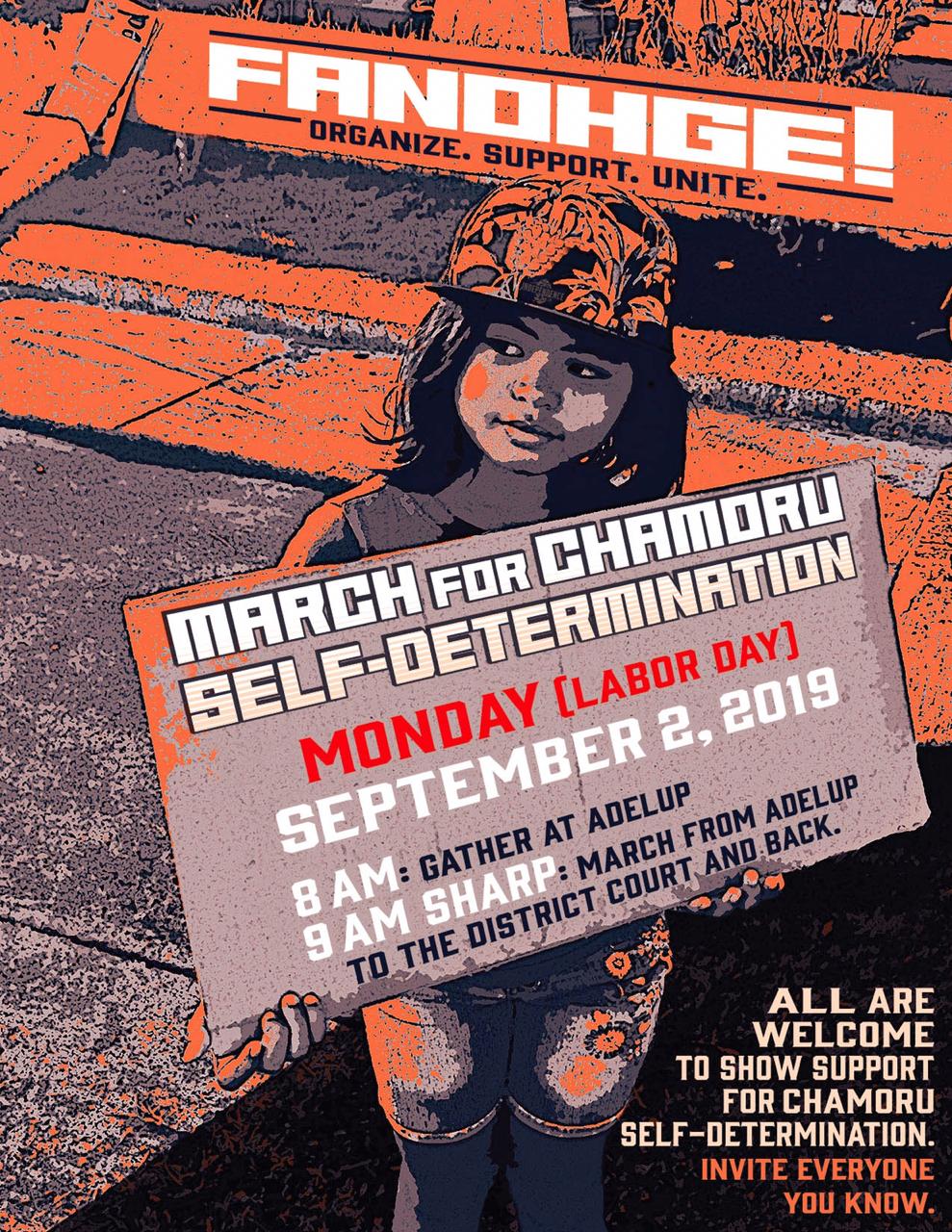Fanoghe March for CHamoru Self-Determination
Fanoghe March for CHamoru Self-Determination
- Status: Past Project
- Possible Hours: 8
- Categories: Social Justice, Peace and Kindness, Education and Literacy, Citizenship and Civic Engagement, History and Culture
- Schools: Open to All Schools
- Project Start Date: 09/02/2019
- Project End Date: 09/02/2019
Participate in this historic event! Earn service learning hours by sharing this information and by getting others to participate. ’Fanohge’ is the CHamoru word for 'stand' and is a call to everyone on Guam to create the largest political gathering in Guam’s history. The purpose is to seek restorative justice by holding the U.S. to its promise to allow CHamorus to vote for their political status.
The Fanohge March for CHamoru Self-Determination encourages respect for the native inhabitants of Guam and brings to the forefront the promise and legal commitment that the U.S. made to the CHamorus. When the United States signed the Treaty of Paris in 1898, it committed itself to guide the people of Guam to self-rule or sovereignty.
Self-determination is the belief that the native people of Guam deserve the opportunity to express their preference for a self-governing political status. Currently, Guam is a colony and an ‘unincorporated territory’. This means that even though we are U.S. citizens, we cannot vote for the President of the U.S., we have a representative in Congress, but he can’t vote, and we have little power with respect to how our island is used by the military and federal government. Independence, statehood, or free association are forms of self-rule or sovereignty, and are preferred over the status quo of being a colony and unincorporated territory.
Since Guam’s political status affects everyone, people of all ethnicities and cultures are welcome to the march. Spread the word and march with your family, clan, or club. All efforts have been made to ensure that the event is peaceful and safe.
Preparation Instruction:
- Go to the Facebook page for Fanoghe March by clicking on this link: #fanohge. Here you will find information sheets and videos that explain why CHamorus should be allowed to vote for a political status such as independence, statehood, or free association.
- Understand the term ‘self-determination’ and why it is so important for CHamorus to be allowed to vote to determine their political status.
- Understand that Guam is currently an unincorporated territory and that the 3 political status choices available to Guam are independence, statehood, and free association. This site will help you understand what these terms mean: http://guamspoliticalstatus.weebly.com/options-for-guam.html
- Read about the political history of Guam to understand how residents of Guam have been trying to seek self-governance for nearly 100 years. The Organic Act of Guam declared that people residing on Guam in 1950, and their descendants, would be American citizens, but with limited rights. https://www.guampedia.com/organic-act-of-guam/
- If you still need more information or help in understanding these terms, ask a Civics or Guam History teacher to help you.
- Make a sign or banner in support of CHamoru Self-Determination. Encourage your family and friends to join you. The goal for the march is to bring out as many people as possible to make it the largest non-political gathering in Guam’s history.
Activity Instruction:
On Monday, September 2
nd, meet at the Governor’s Office in Adelup starting around 8:00 am. The march starts at 9:00 am sharp. Marchers will head to the Federal District Court building, and then return to Adelup for a rally. The event should be over between 11:30 and 12 noon.
A major goal of the March is to get as many participants as possible.
Service:
- Talk to friends, other students, or family members about the importance of self-determination and try to convince at least 10 people to show up and march, the more, the better! Post a picture of your group at the March/rally on the Fanohge March Facebook page.
Wear comfortable shoes and bring a reusable water bottle. Don’t forget your sign or banner. Marching with friends and/or family is highly recommended. To show that you participated, take pictures of you and your sign or banner, pictures of other people’s signs, and the rally portion of the event.
Reflection Instruction:
The story of the CHamoru people includes over 400 years of being ruled by powerful nations, Spain, the United States, and Japan (from 1941-44 during World War II). After the Spanish-American War in 1898, the U.S. signed the Treaty of Paris and promised to lead the CHamoru people, the native inhabitants of Guam, toward some form of self-governance. Recently, U.S. federal courts ruled that it would be racist if non-CHamorus were not allowed to vote. Guam has many people of different cultures living side by side with the CHamorus. Many have been here for years and were even born here. Do you think that the U.S. should honor that promise and only allow the CHamoru people to vote for the political status of their choice, or, do you think that people who are not CHamoru should also be allowed to vote? Try to explain your answer.
What did you learn from the speakers at that rally? Did they explain why self-determination by the native people of Guam is important? Do you think that Guam should move away from its current political status? Why or why not?
During the march, what was your impression of the march and other marchers? Was it a respectful and peaceful event? Would you participate in a future march or event for this cause?
How was this activity an example of service to the community?
Learning Standards/Objectives:
WH1.1 Demonstrate appreciation of the cultural values, languages, lifestyle, and heritage of different ethnic groups.
AG1.4 Describe an example of a government policy that has affected a particular racial, ethnic, or religious group.
GH2.1 Examine and interpret primary and secondary source documents.
GH2.3 Identify and describe historical periods and patterns of change during the eras of Guam history, including the following:
- Ancient Chamorro Society
- Spanish Colonization
- U.S. Naval Government
- Japanese Occupation
- Post World War II
- Modern Guam
WG2.3 Make inferences and draw conclusions about characteristics of selected contemporary societies that resulted from historical events or factors, such as invasion, conquests, colonization, immigration, and trade.
EXAMPLE(S): Bosnia, Northern Ireland
WH2.25 Analyze the worldwide impact of World War I, including the following:
- Economic causes, political causes, major events, and major leaders of the war, with emphasis on Woodrow Wilson and Kaiser Wilhelm II
- The outcomes and global effect of the war and the Treaty of Versailles
- The causes and consequences of the Russian Revolution
U.S. 2.7 Discuss the origin, interpretation, effects, and application of certain documents.
EXAMPLE(S): Mayflower Compact, Declaration of Independence, U.S. Constitution, Bill of Rights, Gettysburg Address, Organic Act of Guam
U.S. 2.11 Evaluate the emerging role of the U.S. in world affairs, including the following:
- The changing policies of the U.S. toward Latin America and Asia and the growing influence of the U.S. in foreign markets
- The U.S. involvement in World War I, including Wilson’s Fourteen Points, the Treaty of Versailles, and the national debate over treaty ratification and the League of Nations
CONTACT PERSON DETAILS
Name: Joni Quenga Kerr
Phone: 797-1477
Organization/Agency/Business Name: GCC Ecowarriors and Fanohge March organizer
Acknowledged by Teacher/Guidance Counselor:
Print name: _____________________________
Signature:_______________________________
Date:______________________










